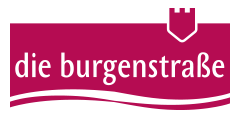Abenberg
Castles and Palaces
Abenberg is located 20 kilometres southwest of Nuremberg, only a few kilometres from the Franconian Lake District with Roth-, Brombach- and Altmühl lake. Landmarks are the 1000 year old castle Abenberg and the 500 year old monastery Marienburg, as a charitable and spiritual centre. The village was first mentioned in 1071 as Abinberch. The Counts of Abenberg built the castle. It was the time of the high Middle Ages and the blessed Stilla, who dedicated her life to the poor and sick. From 1189 to.... [More about Abenberg]

Abenberg Castle - Inner courtyard with lace-making museum.

Abenberg Castle - Justitia.

City and castle Abenberg - Aerial view.

Abenberg Castle - Schotten Tower.
Burg Abenberg
Abenberg Castle
Two towers – the slender "Luginsland" watchtower and the massive "Schottenturm" (Schott Tower) – dominate the striking silhouette of the castle. Neither was built until the 80s of the 19th century.
The castle complex accommodates the Abenberg Castle Museum and the Bobbin Lace Museum. Furthermore the Hotel Abenberg Castle and a restaurant that offers an exquisite cuisine are located there. Some rooms are situated in the "Schottenturm".
In the 11th and 12th centuries Abenberg Castle became the seat of the powerful Counts of Abenberg - church advocates of the bishops of Bamberg. After the Abenbergs had died out around 1200, the Hohenzollerns, by trade the castellans of Nuremberg, inherited the building. About 1230 they began rebuilding today's castle, which went on until about 1250. Later they rarely spent any time here. In 1296 Konrad the Younger sold Abenberg to the bishop of Eichstätt.
In 1806 the castle came into the possession of the Kingdom of Bavaria, which sold the splendid building to a private investor. In 1875 a Munich art dealer bought the castle, saved it from total destruction and began rebuilding. The following owner, the chamber singer Anton Schott, reconstructed the "Schottenturm"and began enthusiastically excavating his castle, but in a rather dilettantish fashion.
After decades of decay the castle was finally bought by the city of Abenberg in 1982 and in 1984 by the District of Central Franconia and they established the museums there. During the renovation work between 1988 and 1992 archaeological investigations were carried out, leading to spectacular finds.
Castle tour “From tower to tower”:
every Sunday and public holiday at 1:30 p.m
On a castle tour "From tower to tower" you will discover the thousand-year history of the castle, where counts once lived, magnificent knight tournaments were held and romantics revived the Middle Ages in the 19th century.
Guided tour: adults 2 euros; Meeting point at 1:30 p.m. at the castle bridge
Burg Abenberg
Burgstraße 16
91183 Abenberg
Telefon +49 (0) 9178 90618
info@museen-abenberg.de
www.museen-abenberg.de
Wasserschloss Dürrenmungenau
At the end of an avenue of lime trees lies the baroque moated castle Dürrenmungenau, which is privately owned and not open to the public. The entire complex with castle, park, orchard and estate is surrounded by a sandstone wall. The buildings are rented out for events.
Dürrenmungenau was the country residence of the Nuremberg patrician Kreß von Kressentein family from 1651 to 1876. The castle, which suffered severe damage during the Thirty Years' War, was only rebuilt in baroque form in 1720/25. In the 18th century, Dürrenmungenau also achieved its cultural heyday, among other things with relationships with the Nuremberg language society “Pegnesian Flower Order”, in which family members were heavily involved. Since 1896, Dürrenmungenau has been owned by Barons Leuckart von Weißdorf and their descendants, who acquired the estate from Wilhelm Löhe, a nephew of the founder of the Neuendettelsauer Diakonische Anstalten. When the complex was fundamentally renovated around 1900, the castle was redesigned in the historicist style and new farm buildings were added.
Wasserschloss Dürrenmungenau
Schloßallee 1
91183 Abenberg
www.schlossduerrenmungenau.de








